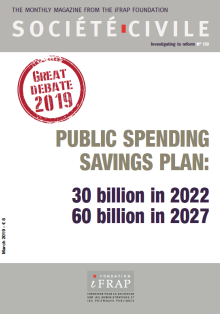Retirement
Public spending : the iFRAP Foundation's plan to save 30 billion euros in 2022 and 60 billion in 2027.

The “yellow vests” crisis demonstrated that our country has reached a level of fiscal exasperation such that a single measure, the rise in fuel tax - could trigger a wave of protest and a social crisis the likes of which have rarely been seen before.
With tax cuts announced at the end of the year for nearly 11 billion euros, together with the great debate subsequently organized, we are witnessing a kind of innovation competition to reform the French tax system rather than tackling our country’s number 1 problem: our record in terms of public spending.
Eurostat statistics show that our country is positioned at 56.5% of national wealth (GDP) in terms of public spending (including tax credits) in 2017 when the EU average is 45.8%. This puts us in first position, in front of Finland and way ahead of Germany (43.9%) or Sweden (49.3%). We have chosen to compare ourselves with these two countries to show that it does not come down to simply a choice of social model, as Sweden and Germany have public services and a social protection system at least as ambitious as ours, it is also a public management system that must be reformed. As such, we spend 287 billion euros more than the Germans or 163 billion euros more than the Swedes.
With international statistics, we can compare ourselves more accurately in each public policy area based on a nomenclature of public spending by function:
- hence, compared with Germany, we spend: 63 billion more on economic actions, 21 billion more on healthcare, or even 92 billion more on pensions despite Germany’s falling population figures.
- compared to Sweden, we spend 14 billion more on the environment and 15 billion more on unemployment.
Therefore, economic levers are very decisive. The President of the Republic wrote to the French people to ask for their opinion on taxation, public spending, ecological transition and institutions. In particular, he asked them “ What savings do you think should be made on priority? ” The iFRAP Foundation submits its action and transformation plan to reduce spending with 7 topics and 60 billion euros of savings as a target for 2027. This effort would put our public finance trajectory back to 52% of GDP in 2022
